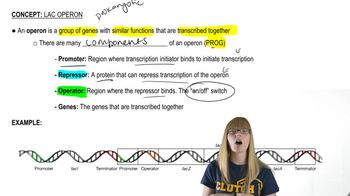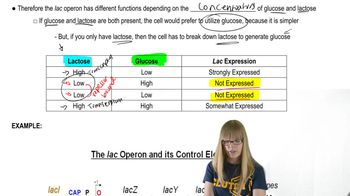Table of contents
- 1. Introduction to Genetics51m
- 2. Mendel's Laws of Inheritance3h 37m
- 3. Extensions to Mendelian Inheritance2h 41m
- 4. Genetic Mapping and Linkage2h 28m
- 5. Genetics of Bacteria and Viruses1h 21m
- 6. Chromosomal Variation1h 48m
- 7. DNA and Chromosome Structure56m
- 8. DNA Replication1h 10m
- 9. Mitosis and Meiosis1h 34m
- 10. Transcription1h 0m
- 11. Translation58m
- 12. Gene Regulation in Prokaryotes1h 19m
- 13. Gene Regulation in Eukaryotes44m
- 14. Genetic Control of Development44m
- 15. Genomes and Genomics1h 50m
- 16. Transposable Elements47m
- 17. Mutation, Repair, and Recombination1h 6m
- 18. Molecular Genetic Tools19m
- 19. Cancer Genetics29m
- 20. Quantitative Genetics1h 26m
- 21. Population Genetics50m
- 22. Evolutionary Genetics29m
12. Gene Regulation in Prokaryotes
Lac Operon
Problem 30c
Textbook Question
For an E. coli strain with the lac operon genotype I⁺ P⁺ O⁺ Z⁺ Y⁺, identify the level of transcription of the operon genes in each growth medium listed. Specify transcription as 'none,' 'basal,' or 'activated' for each medium, and provide an explanation to justify your answer.
Growth medium contains lactose and glucose.
 Verified step by step guidance
Verified step by step guidance1
<span>Step 1: Understand the components of the lac operon. The lac operon in E. coli consists of the genes lacZ, lacY, and lacA, which are involved in lactose metabolism. The operon is regulated by the presence of lactose and glucose in the environment.</span>
<span>Step 2: Identify the role of the I⁺, P⁺, O⁺, Z⁺, and Y⁺ components. I⁺ represents the wild-type repressor gene, P⁺ is the promoter, O⁺ is the operator, Z⁺ is the beta-galactosidase gene, and Y⁺ is the permease gene. These components are all functional in this genotype.</span>
<span>Step 3: Consider the effect of lactose on the lac operon. Lactose acts as an inducer by binding to the repressor protein (produced by I⁺), causing it to change shape and release from the operator (O⁺), allowing transcription to proceed.</span>
<span>Step 4: Consider the effect of glucose on the lac operon. Glucose presence leads to low levels of cyclic AMP (cAMP), which is necessary for the activation of the catabolite activator protein (CAP). CAP-cAMP complex is required for high levels of transcription of the lac operon.</span>
<span>Step 5: Determine the level of transcription. In the presence of both lactose and glucose, the repressor is inactive due to lactose, but the low cAMP levels due to glucose mean that CAP is not activated. Therefore, transcription occurs at a basal level.</span>
Recommended similar problem, with video answer:
 Verified Solution
Verified SolutionThis video solution was recommended by our tutors as helpful for the problem above
Video duration:
3mPlay a video:
Was this helpful?
Key Concepts
Here are the essential concepts you must grasp in order to answer the question correctly.
Lac Operon Structure
The lac operon in E. coli consists of several key components: the promoter (P), operator (O), and structural genes (Z and Y) that code for enzymes involved in lactose metabolism. The genotype I⁺ P⁺ O⁺ Z⁺ Y⁺ indicates that all necessary elements for operon function are present and functional. Understanding this structure is crucial for analyzing how the operon responds to different growth conditions.
Recommended video:
Guided course

Lac Operon Overview
Regulation of the Lac Operon
The lac operon is regulated by the presence of lactose and glucose. When lactose is present, it binds to the repressor protein, allowing transcription to occur. However, the presence of glucose inhibits the operon through catabolite repression, which prevents the activation of transcription even if lactose is available. This dual regulation is essential for understanding transcription levels in various growth media.
Recommended video:
Guided course

Lac Operon Regulation
Transcription Levels
Transcription levels of the lac operon can be categorized as 'none,' 'basal,' or 'activated.' 'None' indicates no transcription occurs, 'basal' refers to low-level transcription under certain conditions, and 'activated' signifies high transcription rates. In the context of the provided growth medium containing both lactose and glucose, the presence of glucose will lead to 'none' or 'basal' transcription due to catabolite repression, despite lactose being available.
Recommended video:
Guided course

Eukaryotic Transcription

 4:27m
4:27mWatch next
Master Lac Operon Overview with a bite sized video explanation from Kylia Goodner
Start learning

